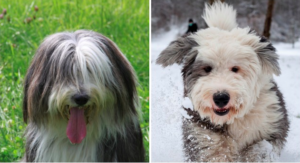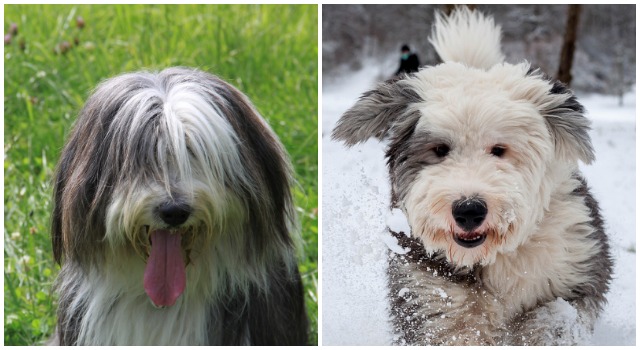
There are so many different types of dog breeds from all over the world, and unsurprisingly, some look incredibly similar! With look-alike markings, coats, and statures, it’s no surprise that some of these “twins” can even stump dog aficionados.
Can you tell the difference between the dog breeds below? (Hint: not all the photos are in the same order as the headings!) Quiz yourself on these 12 pairs, and scroll to the bottom of this post for the answers!
1. Norwich Terrier & Cairn Terrier

(Image on left: Brad L.via Flickr / Image on right: Petful via Flickr)
These two breeds have a lot in common: small, sturdy builds, wiry coats, and similar body weights and life expectancies.
However, these two pups have different histories. Cairn Terriers originated in Scotland, where they were bred to hunt rodents who lived in cairns, which were piles of stones used as grave markers. Norwich Terriers were also bred to kill rats, as well as accompany their owners in packs while hunting, but they have roots in Britain.
Both are quite friendly and moderately eager to please, but as terriers, they can have a mind of their own! As long as they’re loved and trained, these pups can make wonderful little companions.
2. Alaskan Malamute & Husky

With similar coats and coloring, these two beautiful sled dogs breeds are often confused.
One of the biggest differences between Alaskan Malamutes and Siberian Huskies is their size. Malamutes, a centuries-old dog breed, are larger and generally stronger than Huskies. They’re able to pull heavier loads across frozen tundras, while Huskies are known for their incredible endurance, hauling lighter loads over longer distances. What’s more, Malamutes have brown eyes, while Huskies can have brown or icy blue irises – or one of each!
Both dogs are highly intelligent, and can make great family pets with the right people. They need to be exercised, stay busy, have ample room outdoors (especially in cooler temperatures), and owners need to know how to reign in their natural prey drive.
3. Collie & Shetland Sheepdog (Sheltie)

These long-coated canines are both herding pups and look very similar except for one major difference: their size!
Collies originated in Scotland and were loved by Queen Victoria. Shelties look like “mini Collies” and were bred small so they’d have small appetites. They’re from the Shetland Islands where inclement weather was known to affect food production, but luckily these expert herders only need a little food to stay full!
Big or small, these pups did not earn their reputation for being loyal for nothing!
4. Boston Terrier & French Bulldog

These two breeds look pretty darn similar, but there are a few distinct differences in physicality and personality.
Boston Terriers can weigh less than Frenchies, and are less muscular and have longer legs. They also have tuxedo-like markings, flatter cheeks, and pointier ears. Frenchies, on the other hand, are more stocky and muscular. Their ears are rounded and they can have a multitude of different coat markings and colors.
Personality-wise, both make wonderful family pets. Frenchies, however, tend to be calmer than Boston Terriers, who may need more exercise. However, as both are brachycephalic breeds, pup parents need to beware of overheating during warm weather or periods of activity.
5. Belgian Malinois & German Shepherd

These two working breeds hail from Germany, and their deep need to do a job while pleasing their people make them popular choices for K9 dogs. Though they look similar — especially when their coats have matching coloring — there are a few marked differences.
The Belgian Malinois breed tends to be smaller and lighter than GSD’s giving them a longer life expectancy. Their coats also often have shorter hair than their look-alike cousins, and they’re known for having distinctive ear and “mask” markings.
While both are incredibly intelligent, protective, and need to stay mentally and physically active to keep out of trouble, GSD’s tend to be a better choice for a family pet. After all, they’re the AKC’s second most popular dog breed for a reason!
6. Great Pyrenees & Kuvasz

(Image on right: Kuvasz Prince of The Dogs Kennel via Flickr)
With similar sizes, weights, and luxurious white coats, Great Pyr and Kuvasz pups can be very difficult to tell apart!
Despite looking like twins, the dogs are from different parts of the world. Pyrs were bred to herd and guard flocks in the Pyranees Mountains (between France and Spain), while Kuvs, who were also guardians, were loved by Hungarian nobles.
Personality-wise, both breeds prefer to be with their families over meeting new friends. Pyrs are known for their patient and calm demeanors (though they do need a lot of exercise!), while Kuvs are admired for their bravery and sweet nature.
7. Pomeranian & American Eskimo

While American Eskimos come in three different sizes (toy, miniature, and standard), and both breeds can have different coat colors, Eskies and Poms of similar sizes and colors can be very difficult to tell apart!
They’re both gorgeously fluffy and can even be described as “perky,” however Poms may be happier staying in the company of their families, making them wonderful watch dogs. On the flip side, Eskies are known for being friendly and outgoing with just about everybody, though they do need a bit more exercise than the lapdog Pom.
Of course their are exceptions, but in general, an Eskie may be happier in a family with small children than a Pomeranian.
8. Lhasa Apso & Shih Tzu

Both small and under 20 pounds, Shih Tzus and Lhasa Apsos with similar coloring and haircuts can look nearly identical.
Shih Tzus were bred as lap dogs by Chinese royalty, and are still known for being one of the most affectionate, family-friendly breeds around. Lhasa Apsos, who were also bred as companions in palaces as well as monasteries in the Himalayan Mountains, tend to be more reserved around unfamiliar people. Still, these pups are known to have a funny side!
Both breeds make wonderful companions, however families with small children and social lifestyles may do better with Shih Tzus. Likewise, homebodies looking for a pet with a more sassy, aloof personality may prefer the company of a Lhaso Apso.
9. Whippet & Italian Greyhound

The reason these two breeds look so similar is that they’re closely related. In fact, Whippets were bred as a smaller version of the Greyhound, and Italian Greyhounds are even smaller than that!
Whippets came about in Victorian England, when coal miners wanted a dog with the racing and hunting capabilities of a Greyhound, but with a much smaller appetite! The Italian Greyhound lineage goes back farther with the pups charming nobility in the Mediterranean around 2,000 years ago.
Both dogs have affectionate and energetic personalities, and both are happy either sprinting their hearts out or lounging on the couch. However, since toy-sized Italian Greyhounds are so delicate, a family with small children might do best with a Whippet or standard-sized Greyhound.
10. Bearded Collie & Old English Sheep Dog

(Image on left: Caroline Léna Becker via Flickr/ Image on right: Norlando Pobre via Flickr)
With soft, shaggy coats and gray and white coloring, these two lovable breeds can be easily confused.
One of the most obvious differences is the dogs’ size. Old English Sheep Dogs are considered “large,” weighing 60-100 pounds, while the medium-sized Bearded Collie is usually between 45-55. Bearded Collies are also known for — you guessed it — the “beard” that grows around their snout!
While both herding dogs love playing in and exploring the great outdoors, Beardies are known for being exceptionally outgoing, while Old English Sheep Dogs are gentle, but more reserved.
11. Portuguese Water Dog & Poodle

The dark, curly coats of Portuguese Water Dogs can look very similar to like-colored Poodles!
While both dogs are athletic and bred to excel in the water, Porties were specifically meant to be fishermen’s companions, and are still used in water rescue. Poodles, hailing from Germany, were bred as duck hunters.
Both Porties and Standard Poodles are considered medium-sized. However, Poodles are known for their exceptional trainability, while Porties are particularly affectionate. Either of these breeds can make wonderful family companions, and usually to do well with children.
12. Scottish Terrier & West Highland Terrier

Both small terriers with slightly shaggy hair, it’s not difficult to confuse one of these breeds with the other. However, people who know what to look for can easily tell these dogs apart!
Scotties can come in different hues, including a “wheaten” shade that looks most similar to the Westie’s white coat! Scotties also have a longer snout that ends in a beard, while Westie’s snouts are noticeably shorter. Both were bred to hunt vermin, with Scotties hailing from the Scottish Highlands, while Westies are named for the northwestern part of Scotland.
Though they’re little, both breeds are quite sturdy and make wonderful pets for all kinds of families!
ANSWERS:
1. Cairn Terrier (L) / Norwich Terrier (R)
2. Alaskan Malamute (L) / Husky (R)
3. Collie (L) / Shetland Sheepdog (R)
4. French Bulldog (L) / Boston Terrier(R)
5. Belgian Malinois (L) / German Shepherd (R)
6. Great Pyrenees (L) / Kuvasz (R)
7. American Eskimo (L) / Pomeranian (R)
8. Shih Tzu (L) / Lhasa Apso (R)
9. Italian Greyhound (L) / Whippet (R)
10. Bearded Collie (L) / Old English Sheep Dog (R)
11. Poodle (L) / Portuguese Water Dog (R)
12. Scottish Terrier (L) / West Highland Terrier (R)
How did you do? Tell us in the comments below!
via Whisker Therapy